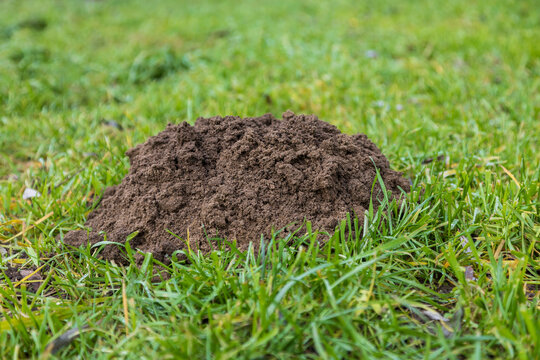
You’re sipping coffee on your patio, admiring your yard—and then you see it: a small pile of dirt that wasn’t there yesterday. It might not look like much, but what lies beneath could wreak havoc on your landscaping. If you’ve ever asked, “What do mole holes look like?”, you’re not alone. At Got Moles, we help homeowners uncover the mystery (and menace) of underground invaders before it’s too late.
Let’s walk you through the unmistakable signs of mole activity, how to spot mole holes, and why getting professional help is your best defense.
What Do Mole Holes Look Like? The First Clues
The most common question homeowners ask is, “What do mole holes look like in a yard?” Mole holes aren’t like open pits or large animal dens—they’re subtle, sneaky, and easy to overlook.
A mole hole often appears as a mound of fine, mounded dirt—not an open hole. These small mounds, known as molehills, resemble little volcanoes with no visible entry or exit point. Unlike gopher holes, which are open and crescent-shaped, mole holes are usually plugged with soil, giving no clue about what lives underground.
At Got Moles, we train our experts to identify mole holes accurately and quickly, saving your lawn from further destruction.
The Signature Look of Molehills
You’ll often find multiple molehills scattered across the yard. They typically show up in straight or winding lines, following the pattern of the mole tunnels beneath the surface. These mounds consist of loose, finely ground soil that’s pushed upward as the mole digs through your lawn.
What makes mole mounds unique is their shape—they tend to be more conical and centered than those made by gophers, which tend to be fan- or crescent-shaped.
Got Moles uses this distinction to separate mole activity from other pest infestations so we can recommend the right solution from the start.
Surface Tunnels: A Tricky Tell
If you’re walking across your lawn and suddenly feel soft spots or raised ridges underfoot, those are likely surface tunnels created by moles. These shallow tunnels disturb the grass and allow moisture to accumulate, weakening root systems.
These tunnels not only ruin the appearance of your yard but also compromise its structure. At Got Moles, we specialize in tracking these patterns to identify where moles are most active.
Difference Between Moles and Gophers
Many homeowners confuse moles with gophers, but their behavior—and the damage they cause—are different. While both animals live underground, their burrows tend to vary.
- Moles create long, winding tunnels with mounded dirt in cone-shaped piles.
- Gophers make open holes with irregular, crescent-shaped mounds.
At Got Moles, we’re not just about removal—we’re about accurate identification. Knowing the difference is the first step to solving the problem.
Understanding Mole Tunnel Systems
What moles do beneath your yard is nothing short of architectural. Their burrows and tunnels serve as both hunting paths and homes. These networks can stretch over 100 feet and consist of both shallow surface tunnels and deeper living quarters.
This subterranean network can cause widespread damage quickly. The professionals at Got Moles use proven strategies to map these tunnels and stop the mole activity at the source.
Role of Soil and Lawn Health
Soft, moist soil is like a welcome mat for garden moles. Lawns with rich earthworms, grubs, and other insects are prime real estate for hungry moles. If your lawn is overwatered or has poor drainage, it becomes even more attractive to burrowing pests.
That’s why Got Moles not only removes moles but also helps improve lawn services to deter future infestations. Prevention is just as important as elimination.
Why You Should Act Quickly
Delaying action allows the mole tunnels to expand and the mole mounds to multiply. The longer moles are left to tunnel through your yard, the more damage they’ll inflict on your landscaping and garden infrastructure.
Whether it’s the destruction of grass roots, upheaval of flower beds, or disruption of sprinkler systems, Got Moles can step in fast—before your backyard becomes a mole metropolis.
Don’t Be Fooled by the Surface
You might not see the moles, but their signature is written all over your lawn. From subtle molehills to lumpy surface tunnels, these critters leave a trail. But identifying the appearance mole damage takes a trained eye.
At Got Moles, we know that what’s on the surface is only part of the story. Our inspections go deep—literally—so we can stop the destruction where it starts.
The Trouble with DIY Mole Control
Over-the-counter traps and repellents might seem appealing, but they rarely target the full network of mole holes and burrows. Most DIY methods address symptoms—not the cause.
That’s why Got Moles offers professional-grade solutions tailored to your specific infestations. Our team understands mole behavior, tracks mole activity, and uses humane and effective methods for long-term success.
When to Call Got Moles
If you’ve spotted one or two molehills, it may already be a sign of a larger mole tunnel system. The best time to act is now. Our team at Got Moles is ready to assess, diagnose, and remove moles quickly and professionally.
We don’t just remove the problem—we work to prevent it from coming back. Whether your yard is suffering from mole holes, gopher confusion, or other underground invaders, we’re your go-to experts in pest-free landscapes.
Call the Pros Before the Mounds Multiply
Your yard deserves better than being a playground for moles. At Got Moles, we specialize in identifying and removing these elusive pests before they ruin your landscape. Don’t guess—get expert answers and real results.

